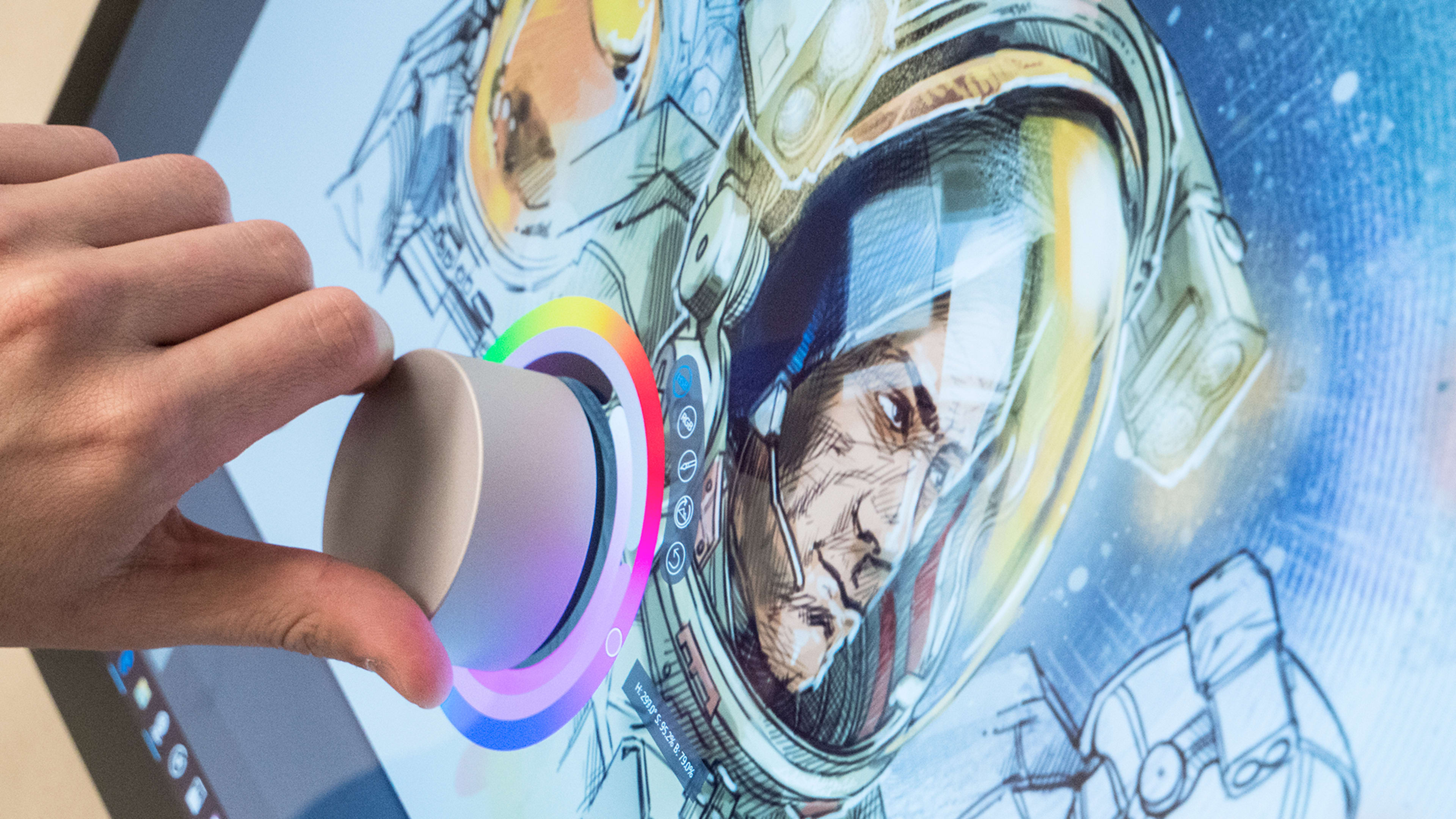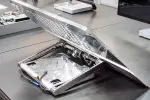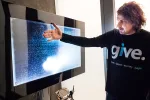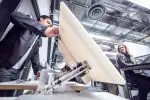“Lean on it!”
Panos Panay, Microsoft’s hardware chief, is gesturing toward the company’s newest Surface device. Confused, I ask him what he means. “Lean on it!,” he repeats.
I don’t want to do it–after all, busting a new computer during an interview is bad optics. So he does it himself. Panay slouches over the 28-inch display of the new Surface Studio desktop PC with his left arm cradling the workspace on the screen in front of him. The display stays put.
Moments before, he had grabbed the top of the display and pulled it downward from its upright position until its bottom rested on the desktop in front of us and the rest angled backward to a 20 degree angle above the table. It kneeled. That 20 degree angle, it turns out, is the same angle illustrators like to position their sketch pads. In effect, the whole screen—a touch screen, mind you—turned into a digital drafting table.
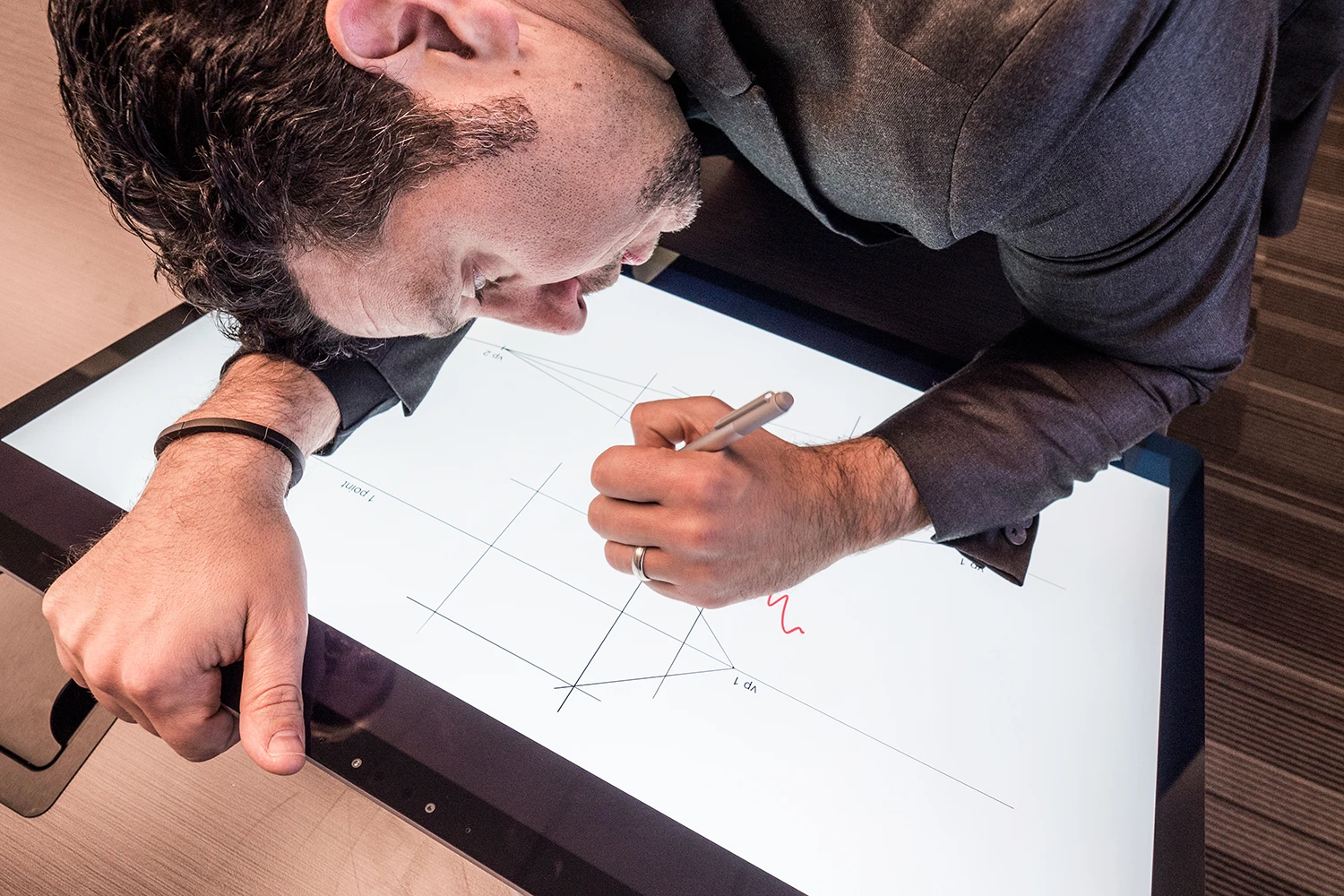
The Surface Studio, which starts at $3,000 and goes up to $4,200 for a fully loaded version, isn’t targeted at average desktop users. Microsoft named it “Studio” because it’s aimed at giving creative types like designers, engineers, architects, and illustrators all the tools and power they need to practice their craft as well as perform everyday computing tasks such as email and web browsing, all in one place.
With this desktop machine, Microsoft took many of the features, design themes, and materials from the Surface tablets and the Surface Book laptop and applied them to a machine for the desktop—the first one it’s ever designed and marketed. Like other Surfaces the Studio uses the pressure-sensitive Surface Pen as an input device. (The Studio’s version is similar to the one that shipped with the Surface Pro 4, but with some upgraded electronics.)
The Studio’s other input device is an optional rotary dial that sits directly on the touchscreen and calls up contextual menus, which the display situates around its base. The Dial, as it’s called, is a prime example of Microsoft’s effort to blend real-world experiences with digital ones in the interest of helping creative types stay in the zone.
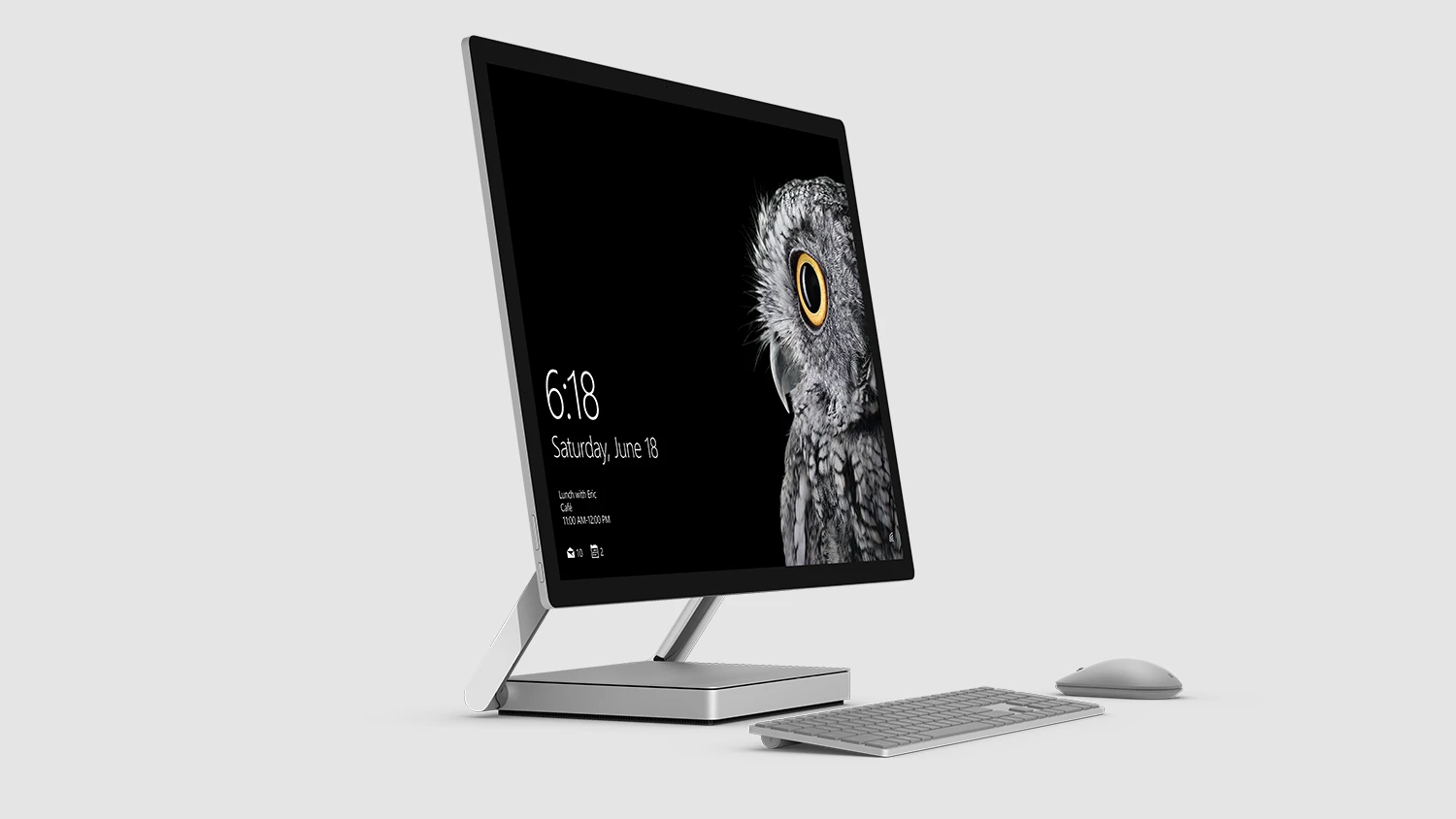
“What we wanted to do with this product is take you from being the most productive person to the most creative person, and bring them as close together as you can possibly could be,” Panay says. “That when you went to your desk, your desk was transformed into a studio—it was the thing you wanted to get back to.”
Panay oversaw development of all previous Surface devices and in 2015 was given control of engineering for other Microsoft hardware, including HoloLens, Xbox, and phones. An energetic, bearded 40-something, he can be a little intense at times. And he sometimes lapses into a Steve Jobsian “Isn’t this magical?” patter. But you get the feeling that it’s all coming from a good place. He believes deeply in the products the Surface group is building, and in the ways the machines pull real creativity and productivity out of users.
What, Another Desktop PC?
I’d come to Building 87 on Microsoft’s huge Redmond, Washington campus to see a new Surface machine, but I’d been told little about it. When the device was lifted up from under a conference table by Surface Studio product lead Pete Kyriacou, my first reaction was, “Does the world really need another all-in-one PC?” The category is already well established and popular, represented most prominently by Apple’s iMac, which pioneered it.
Panay tells me he doesn’t like to call the Studio an all-in-one, and I see his point. With its kneeling display, and pen and Dial input devices, the Studio seriously stretches the definitional limits of the term. When I saw the lengths to which his team had gone to put all the tools creatives need close at hand, I started to see how the Studio could be a real alternative to the Apple computers long considered the default choice by designers and artists.
Based on the release timing of the last few Surface tablets, it was reasonable to expect the next one, the Surface Pro 5, to be announced at the company’s October 26th event in New York City. Instead, we’re getting a desktop PC for creatives. (The Surface Pro 5 is in the works and will launch next year, says a source with knowledge of Microsoft’s plans.) Microsoft is taking preorders for the Studio starting today and says it will ship in limited quantities by the holiday season; broader availability at Microsoft Stores and select Best Buy locations will follow in early 2017.
And, really, a desktop PC for creatives isn’t a complete surprise. Last year’s Surface Book was aimed at designers and power users, and started at an imposing $1,500 at launch. In fact, the Surface line as a whole has been shifting toward the high end, as the Surface Pro found its market and the lower-priced, less-powerful Surface RT and Surface 3 failed to set the world on fire.
Scuttlebutt about the Surface Studio, and even its internal code name, “Cardinal,” had been swirling through the rumor sites for months. A 2015 patent for a “modular computing device” showing the exact outlines of the new machine showed up last winter. But as I would soon find out, the patent sketches and rumors didn’t tell the whole story—not even close.
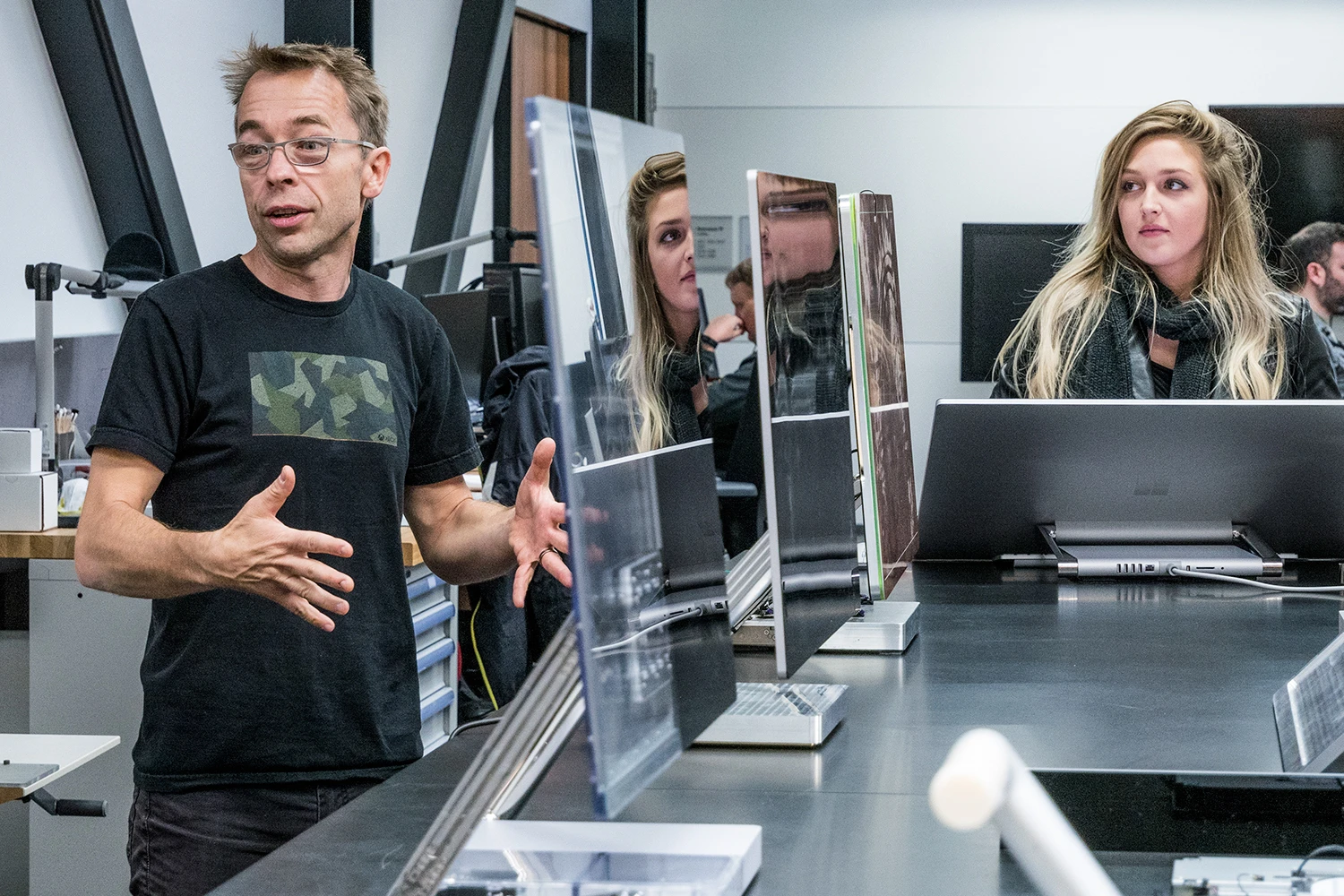
The Display As Drawing Board
The Surface Studio consists of a low-profile base unit that sits on the desktop and houses the guts of the computer. Those components include Intel’s core i7 processor, a powerful Nvidia graphics processor, and a pair of stereo speakers, and the PC uses three fans and a heat pipe to keep it all cool. As Panay steps through these features, the included mouse and keyboard are sitting there, but he says nothing of them. He wants to talk about the display.
A two-armed chrome hinge extends from the base to hold up the 28-inch display, which is only 12.5 millimeters thick. When the display is in its kneeling position, it completely hides the base and the chrome arms of the hinge.
When Panay leans on the 13-pound display, the arms of the hinge behind it seem to have no trouble with the weight pressing down on it. I hear no creaks or groans. Nor does the display wiggle around. This is crucial for designers and illustrators drawing exacting lines on the touch screen, and a design concern that makers of conventional all-in-ones don’t have to worry about.
Senior mechanical engineer Robyn McGlaughlin explains to me that the chrome hinge is loaded with 11 springs that work together to create a fixed range of motion between the upright display position we’re used to on the desktop, and the 20-degree drawing-board mode. The user can position the display at any point between those two extremes. As the hinge moves downward from its upright extreme it begins rotating the display upward until it reaches the 20 degree position at the bottom of the range.
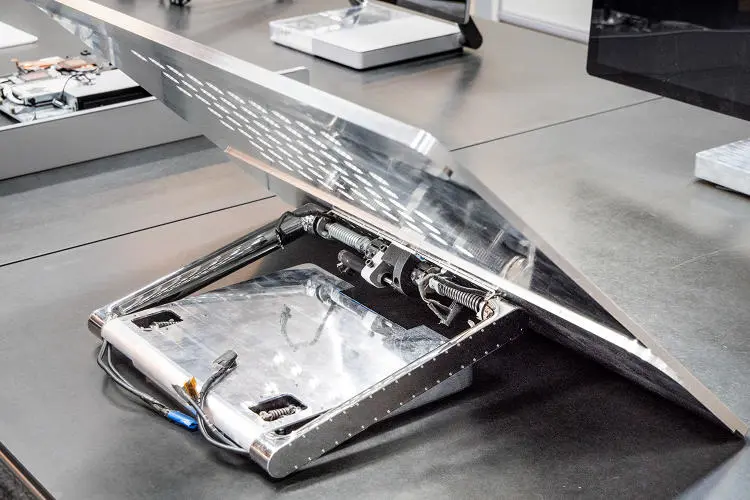
Ralf Groene, who leads Industrial Design for the Microsoft Devices group, says that he believes users will use the drawing-board display position for detailed work, then use the upright position to get perspective.
“I have this awesome picture of Matisse where he works on this huge piece and then he steps back from the canvas,” he says. “You do this in your work, when you are working on the detail. . . working on this little solution here and then you step back to see how it fits within the whole—we all do this.”
Microsoft industrial designer Kait Schoeck (who is, incidentally, one of the inventors of the Surface Book’s unique hinge mechanism) tells me how the display positions fit into her workflow. “I do my normal CAD, fast sketching, whatever, [in sketchpad mode],” she says. “And then kind of prop it up and zoom back and do little tweaks here and there.”

Not About The Megapixels
You’d expect that a $3,000 computer for artists and designers would have a retina-class display, and the Studio does. But making the pixels imperceptibly small wasn’t the only challenge.
“The role of the display is … to re-create the things you see in real life on the screen as accurately as possible,” says Stevie Bathiche, a 19-year Microsoft veteran whose title is “Distinguished Scientist/Director of Research, Applied Sciences Group.” As you might guess, he has a big brain. He’s also a personable guy, tall and gangly with slightly out-of-control black hair. He talks fast, but, it seems to me, not quite fast enough to keep up with his brain.
Bathiche says that the strategy for building the display was to get it tuned perfectly with the operating system and apps, rather than going for spec records. Perhaps the most striking example of this optimization was when the Surface team decided to make the display true-to-scale, so that a character in 12-point font on the screen would be exactly the same size as the same character printed out on paper. An 8.5-by-11 piece of paper held up to the screen matches perfectly the size of its digital cohort–a major benefit for designers creating stuff that will eventually end up in print.
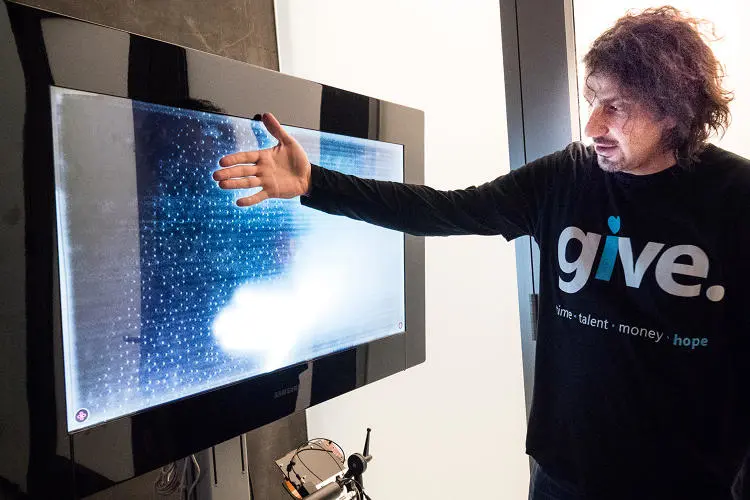
When Bathiche and his team were working out the specifications for the Studio monitor, Apple had recently released a 27-inch iMac with a 5K display. “I had the option to very easily beat Apple without really doing anything in resolution,” Bathiche said. “So I went to Panos and said ‘we can beat Apple by a megapixel, or we can do a true-to-scale display.’” Panay and Bathiche agreed that true-to-scale trumps bragging rights.
But the screen resolution and dimensions had to work out just right mathematically to make it all work. This started with a hard requirement that the display’s have 192 dots per inch (DPI), because it made it possible for Windows 10’s scaling software to work out the number of pixels necessary to display text and objects in their actual size on the display. That key number then dictated some of the other key specs, such as the screen’s diagonal measurement of 28.165 inches.
The Studio display ended up having 4.5K resolution versus Apple’s 5K. “That gives us 13.5 million pixels, which is a million and a half less than Apple, but more than enough to make the pixels disappear,” Bathiche explains. “I’m trading off this tiny bit of resolution that doesn’t matter at all.”
When I stared closely at the Studio display, I could see no pixilation. And the clarity and color depth is as good as anything I’ve seen on a screen that size.
The Disappearing Computer
During my Microsoft visit, I heard the Surface Studio’s inventors say over and over that they wanted to make a piece of hardware that brings creators up close and personal with their work. They like to talk about the theme of “floating pixels,” meaning that the person using the machine is engaged with the touch screen, and everything else on the machine stays out of the way, or better yet, disappears.
This sounded familiar—it’s a mantra repeated by Steve Jobs when Apple introduced the iPad. I also heard a lot of talk about tight and elegant integration of software and hardware, another big Apple theme from way back. Apple may have embraced these themes long ago, but both seem very relevant at Microsoft at this point in its history, as it takes on the challenge of building great hardware to run its operating system.
“Part of the philosophy is that the computer creates a stage for software, and we keep everything else quiet,” Groene says.
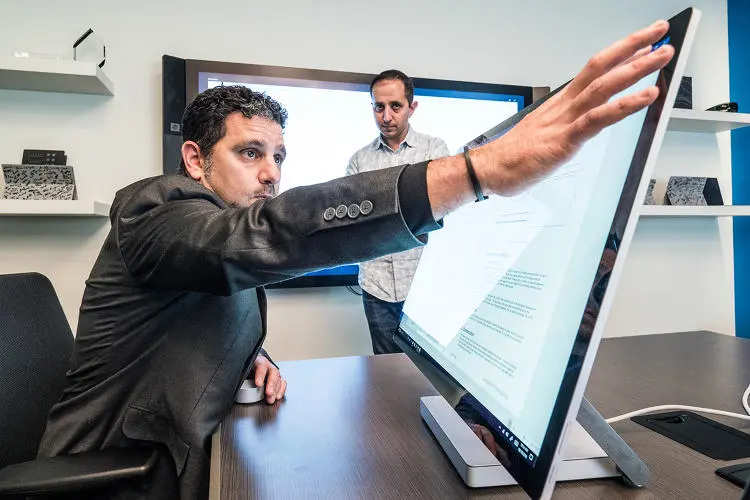
Groene and his industrial design team did a lot to achieve that. There’s almost no bezel around the screen, and no “chin” or “forehead” of black space below and above the display. The base unit and the chrome hinge hide behind the display when it’s in drawing board mode.
The squarish base unit sits squat on the desktop, its outside surface nondescript (but not ugly) and almost completely devoid of details. A narrow groove runs around the machine just below its top edge; it contains small cooling vents, which were a problem for the designers because they created something to look at.
“We have a machine that paints the groove inside here and reduces the contrast that you have between the holes,” Groene tells me. “And [senior industrial designer Tim Escolin] spent weeks with many trips to China making sure that the color is absolutely right and we get everything quiet.”
All of these things have a cumulative effect. The base says “nothing to see here” so well that the eye just moves on. Same strategy with the chrome arms that hold up the display. The designers decided to use chrome so the arms camouflage themselves by reflecting the environment around them. And that’s about the best a piece of metal can do to disappear.
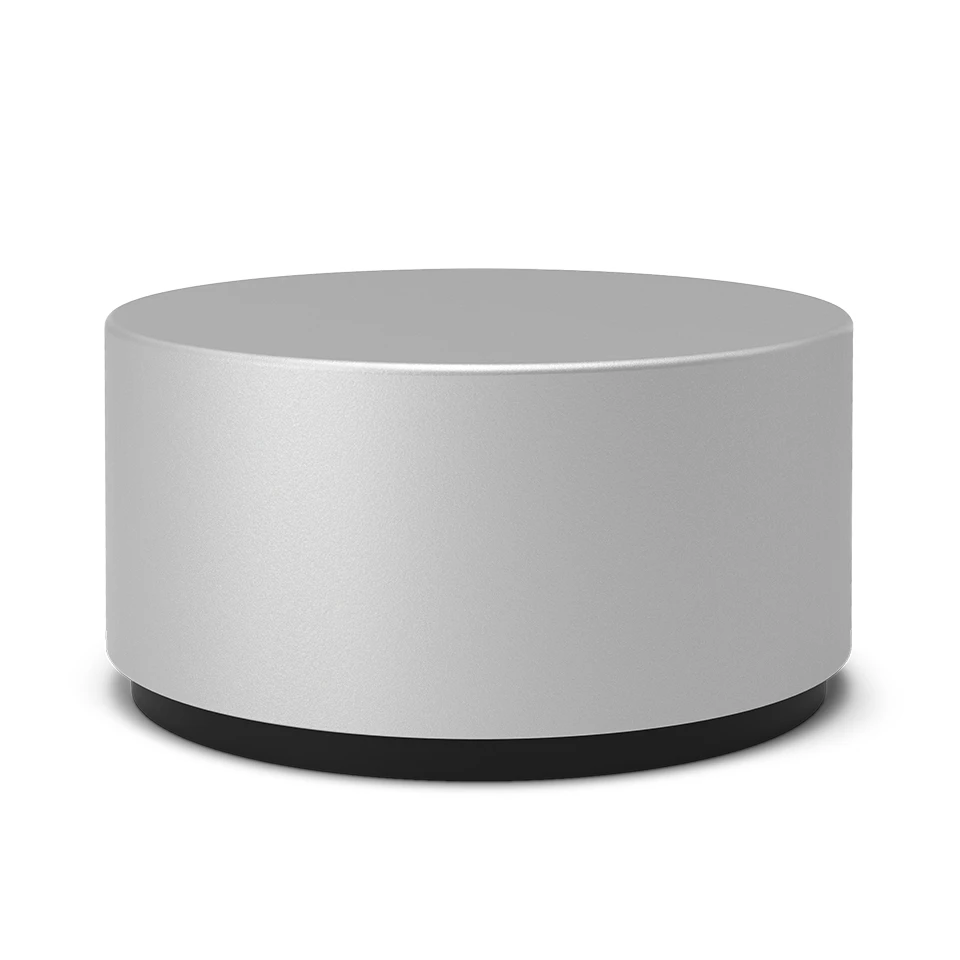
Dialing It In
As Panay continues his conference-room demo, he produces a small aluminum alloy dial–about the size of a large tuner knob on an old stereo receiver–and puts it smack down on the touchscreen, which is then in drawing board mode. The touch screen immediately produces a circular menu around the physical perimeter of the dial. Then he starts turning the dial. By highlighting various menu items, he switches between various modes and functions of the app on the screen. I hear the word “whoa” come out of my mouth.
This was the Surface Dial, a totally new concept to me–if not altogether without precedent. It provides users with an outboard, tactile controller for navigation and selection that would normally be done digitally by tapping on the touch screen. It has a rubbery material on its bottom so it doesn’t slide off (or damage) the Studio’s touch screen. While a mouse’s specialty is pointing, the Dial is designed for scrolling and moving quickly through menus.
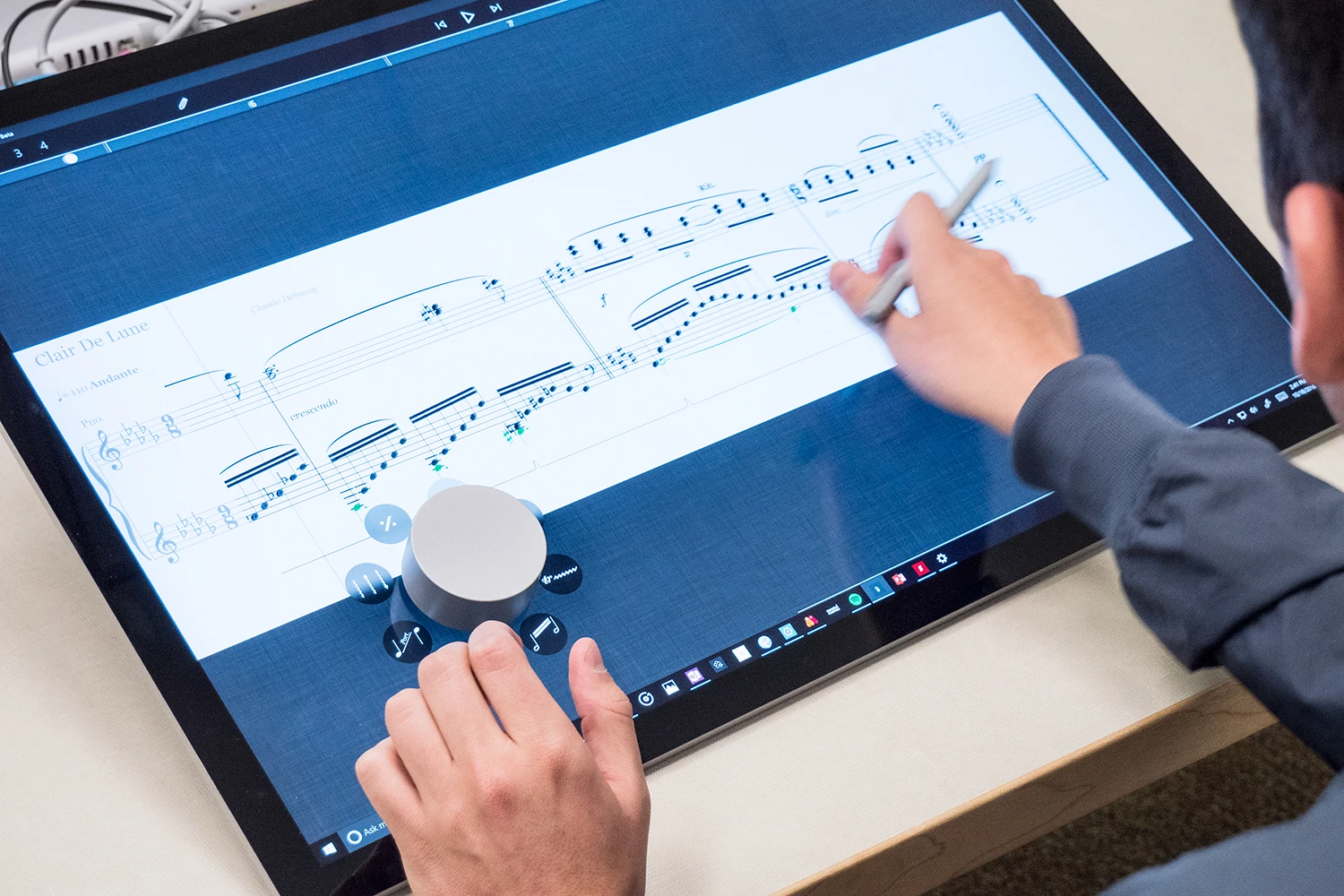
“The vision for a long time when Pete and I were designing this product was connecting digital and analog worlds, and to continue to blend them until everything digital starts to feel analog,” Panay says. “The idea that I can put something on the screen and watch it start to come to life, and this theory that you can blend these two worlds is a pretty impactful one.”
The Dial can be used on the physical desktop or on the touch screen of the Studio, but it’s when the user has the Dial up on the screen in one hand and is using the Surface Pen with the other that the Studio really sings. Back over in Industrial Design, Kait Schoeck sits in a tall drafting chair sketching in the Sketchable app. She has the Pen in her right hand and uses the her left hand to change ink colors and adjust stroke thicknesses with the Dial, which is sitting on the touch screen, in her left. All I see on the screen is a continuous line that keeps getting thicker and narrower and changing color. She tells me she gets so engrossed in sketching or designing on the Studio that the hours pass quickly.
Microsoft will launch the Studio with just seven app developer partners that have created custom on-screen Dial controls in their apps. They are: the CAD app NX (Siemens), the PDF navigation app Bluebeam Revu (Bluebeam), the PDF markup app Drawboard PDF (Drawboard), the illustration app Sketchable (Silicon Benders), the 3D sketch app Mental Canvas (Mental Canvas), the music composition app StaffPad (StaffPad), and the animation app Moho 12 (Smith Micro Software). The developers used an API Microsoft quietly released in August with the Anniversary Edition of Windows 10 to create the Dial controls.
Note that big-name apps such as Photoshop and AutoCAD are not included in that list. Microsoft says it’s now talking to or working with a number of larger developers—including Adobe for Photoshop—that plan to add deeper Dial menus and controls to their apps next year.
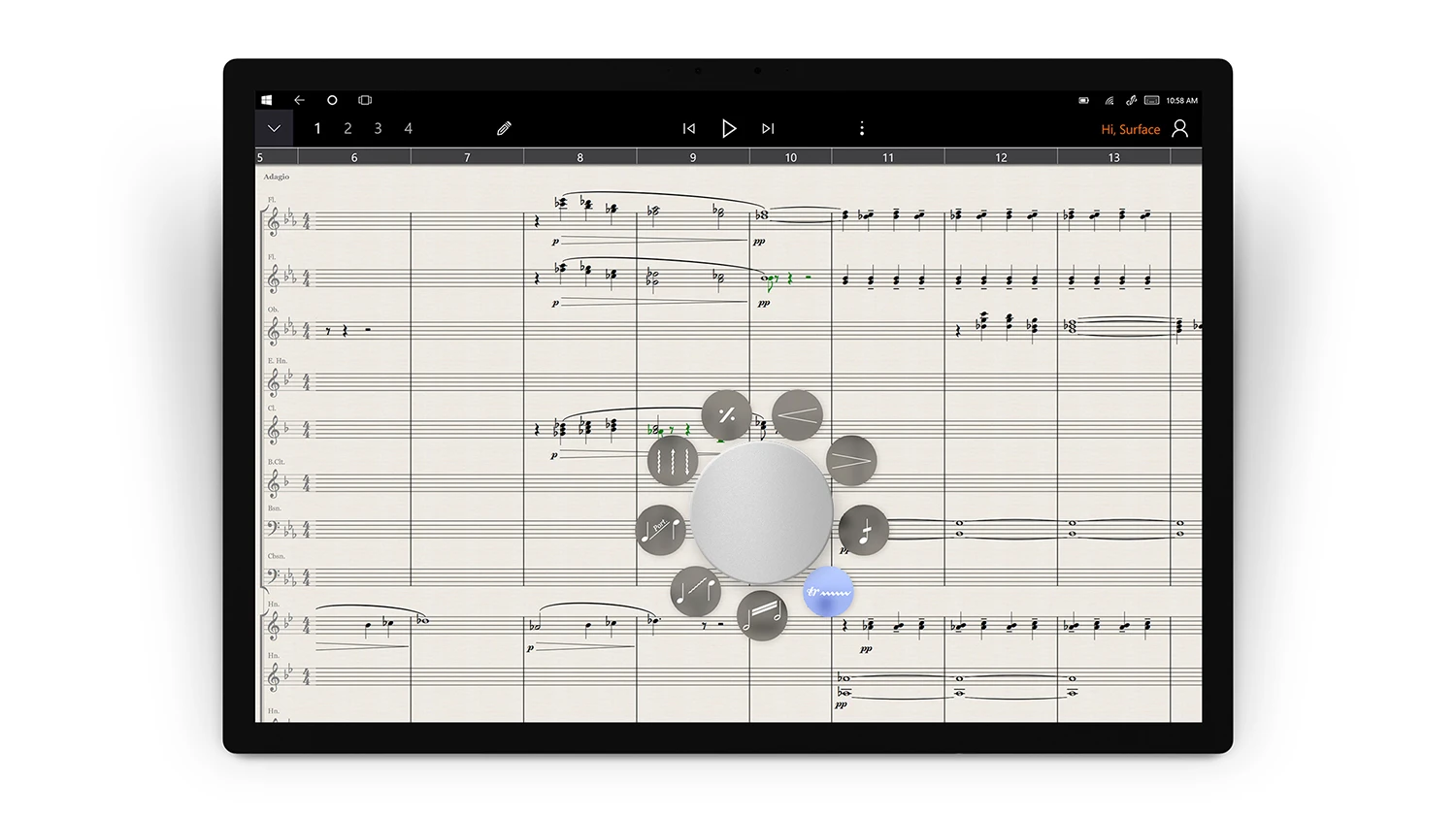
The apps I saw that already have Dial integration use it to keep users locked in on their work rather than fumbling around with app controls. The device is especially handy in apps that use timelines, like music and animation apps. In StaffPad, for example, the Dial lets the music composer move forward and backward in a piece of music, changing notes here and there, all the while hearing the changes in the music through the Studio’s speakers.
StaffPad also wanted to radically simplify navigation by putting many of the most-used tasks, such as play and pause, in a single menu around the Dial. In one of the wilder uses I saw, a composer can pick up the Dial and use it like a rubber stamp on the touch screen to paste oft-used figures to various points on the timeline.
The coolest app I saw running on the Studio with Dial was a 3D illustration app called Mental Canvas. It’s a bit hard to describe, but it helps users make 2D drawings into 3D experiences by mathematically working out the 3D perspectives of objects.
Mental Canvas is the brainchild of a Yale professor named Julie Dorsey, who says that the Studio’s display, pen, and Dial make it the perfect machine for her software. It uses the same general layout and some of the same tools you see in other illustration apps—color wheel, layering, pen settings, etc.—but rather than using a menu around the Dial on the touch screen to switch between modes and tools, the user just moves the Dial near a mode button at the bottom of the screen to go into that mode. This is a big click saver and can help keep the user focused on the work and not on the software.
“There was this kind of confluence of pen technology, and multi-touch through the tablet and so on, that all made the timing for this particular technology just right,” Dorsey says of the Studio. “It’s really like the device. When I saw this I was elated.”
The Dial can be used to do some basic functions in third-party apps without requiring the developer to do any integration work. That’s because the Windows team at Microsoft built a number of Dial functions into Windows 10. These include things like selecting, scrolling, or zooming. For instance, it will work for undo/redo and zoom in Photoshop, no work required on Adobe’s part. Users can also use it in Windows 10 apps such as the Edge browser and Maps.
The Surface Studio and Dial work so well together that it seems like an odd decision on Microsoft’s part not to have bundled them. Instead, the Dial is a $99 add-on, sold separately. (Microsoft is throwing in a free Dial for anyone who pre-orders a Studio from Microsoft or Best Buy before December 1, however.) The Dial also works with other PCs that run Windows 10 Anniversary Edition, but only the Studio lets users place the Dial directly on the screen.
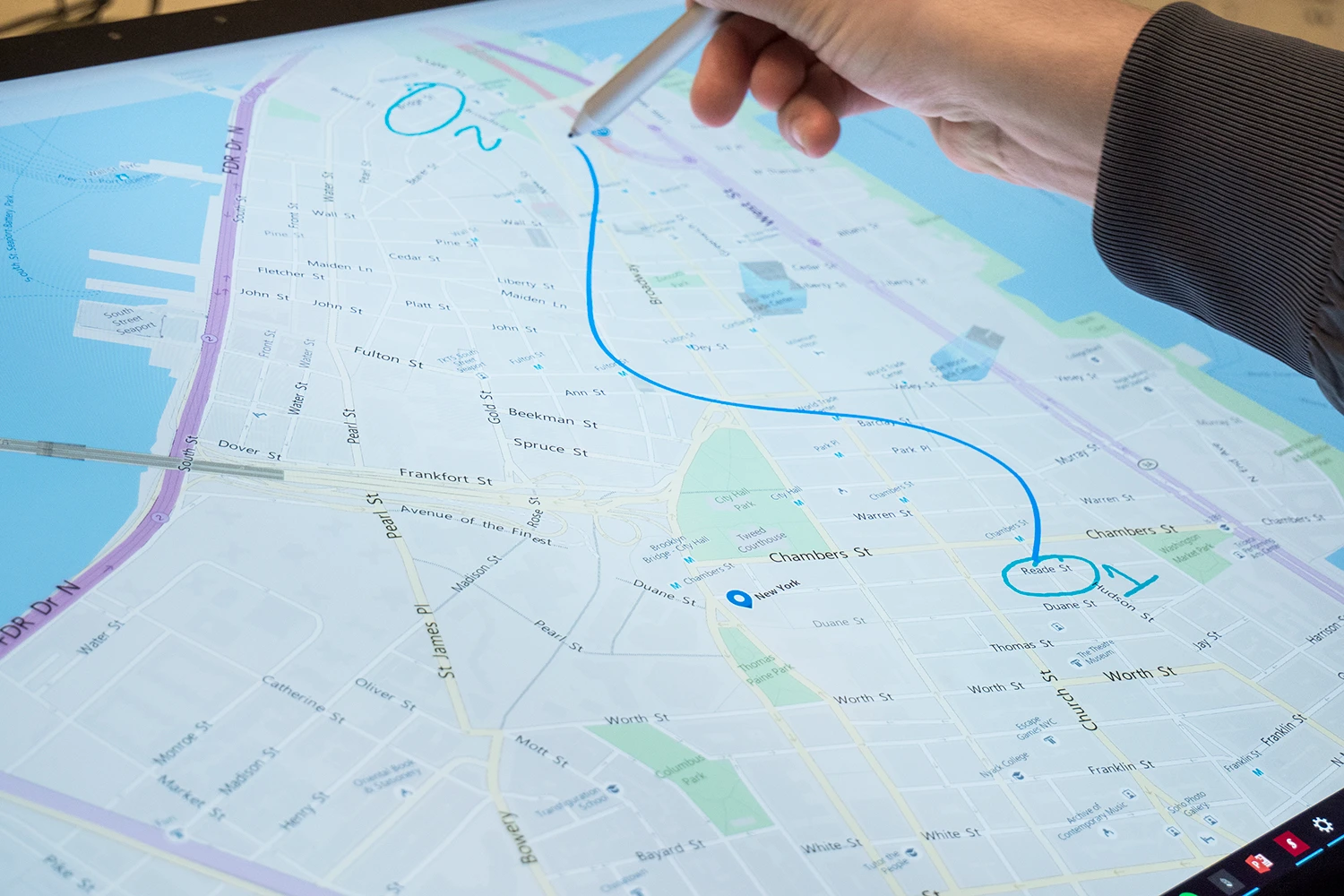
The Surface Dial’s arrival is the fulfillment of a very long-standing dream of Microsoft’s, dating all the way back to the Surface table computer that the company released with much hoopla in 2007. (It didn’t take off and eventually gave up its name to the Surface tablet line.) For that project, Bathiche’s team used infrared cameras that could detect objects placed on the Surface’s, well, surface–such as a board game with real pieces.
“The whole point was that we wanted to have physical objects interacting with digital objects,” Bathiche says. Now the Dial does just that, in a way that enhances the Surface Studio’s emphasis on creative productivity.
Seeya, Cintiq?
In some ways, the Surface Studio’s biggest competitor isn’t any Mac, but rather Wacom’s Cintiq, the pen-and-touch digital display popular with many designers and illustrators. A current model with HD, touch, pen and a comparably sized screen—the 27QHD touch—costs $2,800. That’s not including the cost of a Windows PC or Mac needed to drive the device.
The Studio combines a digital sketchpad and computing functions in one device. “We want to remove all these things around your desk that you think you need to work on, including papers, including a Cintiq or some other thing you were writing on, including any other device that might be on your desktop,” says Panay. “I don’t want to say [the Cintiq] is gone because I’m a big fan of Wacom but, fundamentally what this product is doing is replacing that.”
“It’s nice to stay focused on one device,” says illustrator Mike Krahulik, who cofounded the video-game webcomic site Penny Arcade. He was one of a handful of artists Microsoft chose to beta-test the Studio and the Dial. And before he got his Studio, his desk was dominated by his Cintiq.
“My desk was for drawing and that’s it; I’m not going to play games on my Cintiq, and even if I wanted to I can’t make it sit vertically,” Krahulik tells me. “If I wanted to answer email I did it on my laptop on the little screen.”
Krahulik adds that his only qualm about the Dial is that it doesn’t have the customization options he’d have liked: “It’s incredibly handy and works great out of the box with my drawing software, but I’d love the ability to really go nuts and customize everything about what it can do on a per-program basis.”
People like Krahulik do their design work from a home desk, but the Studio could begin to catch on with companies full of designers, too. I can see a scenario where a large design firm or ad agency might buy Studios for a whole department of creative people. If they’d otherwise need computers and Cintiqs, the Studio’s price tag starts to make sense–assuming that nobody’s so Windows-adverse as to make the Studio a non-starter. Krahulik told me the Surface Pro 3 and Surface Pro 4 have helped Microsoft’s image among creatives.
Panay seems to have realistic expectations about the Surface Studio’s acceptance curve, especially given that its price puts it at the tippy-top of the market. “Don’t get me wrong I hope the demand is off-the-charts great, but it starts at $3,000, so it’s not like we’re coming out with an $800 PC,” he says. “This is a premium [device], it’s for professionals, it’s for creators…”
Yet he doesn’t believe that the Studio will ultimately be limited to commercial customers. “I believe that creators are everywhere,” he says. “There’s going to be a whole group of people who just want this device in their home because it’s beautiful.”
As for sales expectations, “we’re going to take our time; this isn’t one where I’m worried about ‘are we going to ship 100,000 units, or a million units or 10 million units or 20 million units day one,” he tells me. “We’re going to ship the right amount to get it to market so that people can get their hands on it.”
It’s not like the Surface Group at Microsoft is desperate for an immediate hit. Only a few years ago people were making fun of the original Surface, but you don’t hear that very much anymore. In Microsoft’s most recent earnings report, it said that Surface sales (mainly of the Surface Pro 4 and Surface Book) jumped to $926 million for the quarter; that’s a 38% jump from the $672 million in Surface revenue in the same quarter last year. Bulk sales (read: enterprise sales) of 500 devices or more increased 70% year-over-year, the company reported–a fact that helps explain how Microsoft’s PC line fits into the company’s overall strategic emphasis on workplace productivity.
That growth is proof of Panay’s understanding of the market, and it’s gained him some real cachet within Microsoft. It could be that he and his people had some breathing room to plan and build a Surface machine they always hoped to create.
Still, he’s not taking anything for granted. At the end of our meeting he shows me the Studio promo video that will be shown at the October 26 launch event. The music is a cover of “Pure Imagination,” the late Gene Wilder’s signature song in Willy Wonka and the Chocolate Factory. You see some sexy shots of the Studio—the thin display, the chrome arms. You see the Dial in action on the touch screen. You see people getting really into creating things. You see the Microsoft designers, and some of the people who developed apps for the Dial. It’s slick.
As we walk down the hall after our meeting, Panay isn’t sure about the music and whether it will play just right with the audience at Microsoft’s October 26th event.
“When you’re creating, at this point everything is at a paranoid stage,” he says. “You’re powering through and it’s our baby, it’s our latest, you know, and you don’t want to miss, you don’t want to make a mistake.”
Hits and misses are hard to predict, but it’s already clear that Microsoft has brought fresh thinking to the desktop PC with the Surface Studio.
Recognize your company's culture of innovation by applying to this year's Best Workplaces for Innovators Awards before the extended deadline, April 12.
